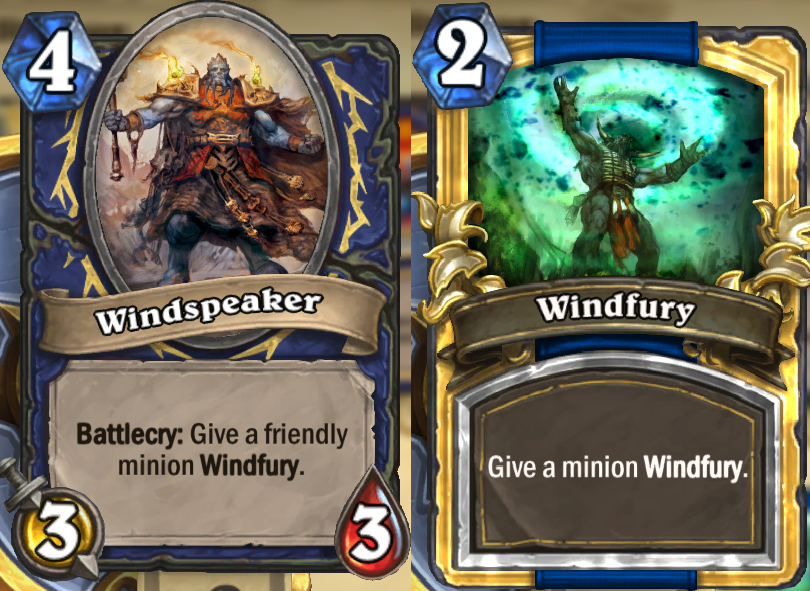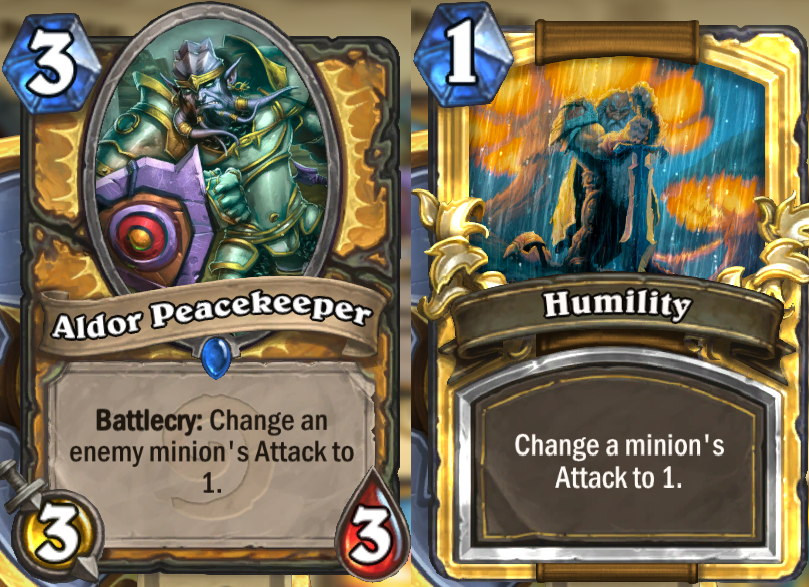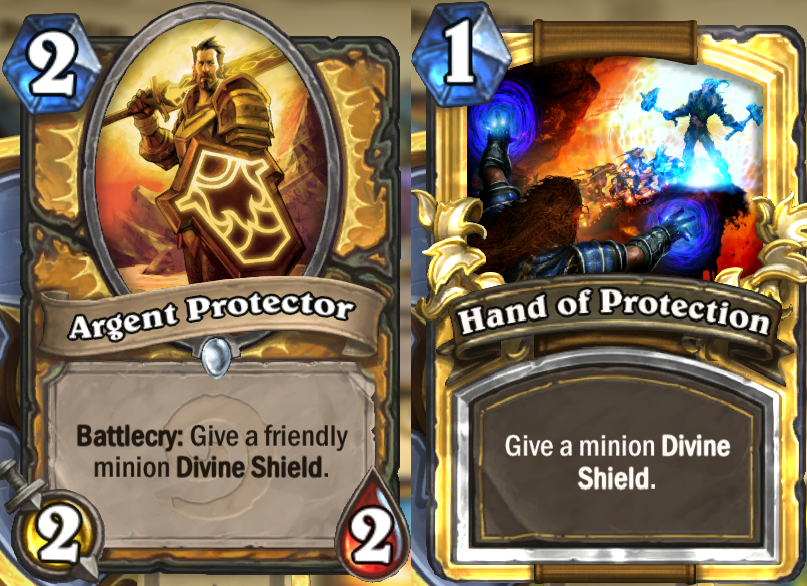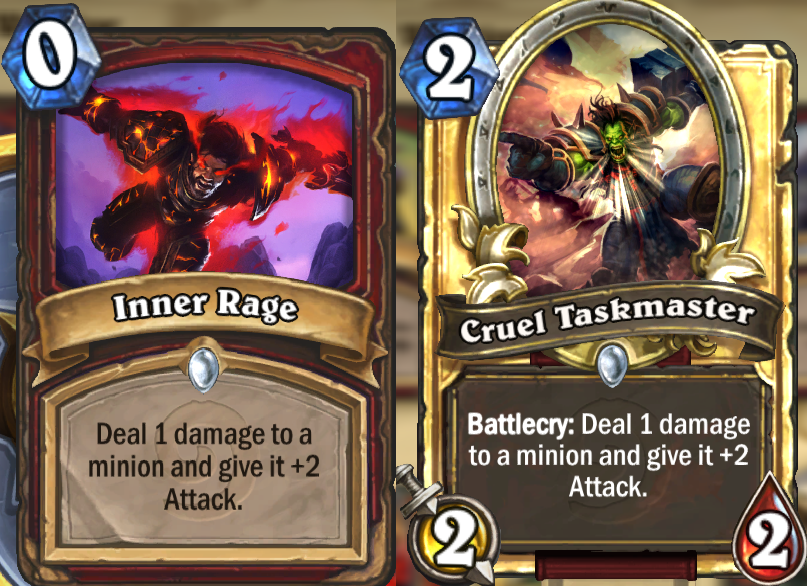Hearthstone: Heroes of Warcraft, Comparing Class Minion Battlecries and their Spell substitutes
Introduction
Every class in hearthstone has its own unique class cards which can help identify their overall type of playstyle. Whether it’s Shaman and their ability to give other minions the effect windfury, or paladin’s and their ability to either humiliate an opponent’s card or give one of their own a divine shield, most classes have both a minion with a battlecry that can activate this effect, and a regular spell as well.
In this article, my aim is to compare a certain class specific spell with the minion that bring along the same effect. By comparing the two, we will be bringing out both the positives and negatives of when to use either of the two options. We’ll be taking a look at Shaman, Paladin, and Warrior as they have the most prominent and obvious of the bunch. So, without any further ado, let’s begin.

Shaman – Windfury vs. Windspeaker
Windfury as its base is a 2 mana cost spell which applies windfury to a given target. Due to its low cost, it’s actually fairly good in use for setting up a near one turn kill play. In its current use, windfury is usually paired with cards like Leeroy Jenkins and 2x Rockbiter for an easy 24 damage for the cost of 8 mana. However, its downfall is that it require you to have a minion in play and the card that you’re applying it to, unless aimed directly at the opponent’s face, needs to be bulky enough to at least survive taking damage from the first enemy minion you target to kill. If it doesn’t then windfury is essentially 2 mana that gets wasted. On the other hand Windspeaker is a 4 mana cost minion that summons a 3/3 into play along with giving one of your friendly units a buff. This card is likely to be used to set up OTK’s (one turn kills) because of its higher mana cost, and so it’s typically used to make a threatening card even more threatening, while providing additional board control by adding another minion in play. The problem that I find with windspeaker is that the most common purpose of the windfury buff is not to trade the creature you give the buff to for a 2 for 1, but rather to output an incredible amount of damage onto your opponent’s face.
A lot of the times when I found myself playing windspeaker, I’d have no minion on the board that could last the initial hit or, more commonly, found myself with this 4 mana card on turn 4 and have nothing to give the buff to with the exception of an 0/2 totem. Thus, I find the spell windfury does its job much more effectively than windspeaker can, simply because high durability minions with enough attack to also take out opposing minions are usually higher up in mana cost. Overall, when playing with windspeaker you end up finding yourself using the card much later in the game, in the hopes that one of your bulky minions survive for a turn.

Not on my watch! Divine shield is an absolutely disgusting spell to play. It always guarantees that the card you cast it on (assuming a minion has been on your board for a turn) will survive, and successfully trade against your opponent’s minion at the cost of only a tiny 1 or 2 mana crystals. Starting off by looking at hand of protection, a 1 mana spell which grants a target divine shield, it’s low cost makes it ideal in making one of your taunt creatures or a big cost minion stay on the board even longer. I’m not a big fan of casting the spell on the same turn you cast the minion for fear of a pesky blood knight or silence to take out the cards effect, essentially losing the value you invested into the card. Overall, because of the cards low cost and the paladin class essentially always looking to keep the enemies board in line, hand of protection does fit the role very well.
On the other hand, Argent protector is nothing to scoff at. For 2 mana, not only do you get the divine shield, but a 2/2 with it. What’s better on turn 2 or turn 3 then having 1 minion on board? Having a second minion on board. Argent protector helps Paladin’s even more than hand of protection does early on in the game by not only allowing successful 2 for 1 trades to occur, but also by continuing to establish board control. Because of its low cost, it also doesn’t hog up your entire turn later in the game, allowing you to get value based on your current board, and continue to fill it out with even more drops on top of it. Overall, both the spell and minion equivalent in this scenario are great cards to have. I’d probably favour the minion in most decks looking to establish board control, but there’s plenty of great uses for the spell as well (experiment with running your own blood knights!).

Paladin – Humility vs. Aldor Peacekeeper
Follow ze rules! Aldor peacekeeper is an absolutely devastating card to deal with. For 3 mana, you place a 3/3 on the board and reduce the attack of one of your opponent’s minions to 1. Let’s recreate a scene: You’ve just gotten to turn 6 and plop down a nice boulderfist ogre that can trade 2 for 1 next turn and get you some board control back against the paladin, only to find out that the paladin has been waiting for one of your big drops so he can play this card. I find that you’ll always have a reason to play Aldor peacekeeper, simply because for the cost and the minion’s base strength it allows for scenarios where the card can trade or help to trade and clear the enemy’s board. Humility also does this, with the bonus of only being 1 mana. The drawback of humility is that it doesn’t contribute to board control as much as Aldor peacekeeper does, which means that unless you have a big card to follow up with or pair humility with a charger, it’s not providing additional board control. This is arguably quintessential the way that Paladin’s are played, which is likely why you don’t see humility picked up as much as Aldor peacekeeper. It’s still a great spell effect, it just simply require you to pair it with additional resources, which Aldor peacekeeper already does for you, while still being a low cost card.
Overall, I find that both cards have their uses, if you’re running a Paladin deck that’s more focused on control though, I would highly favour peacekeeper over humility though, because it gives you a fairly tough minion on board to work with as well.

Warrior – Inner Rage vs. Cruel Taskmaster
In this scenario we have a 0 mana cost spell, which deals 1 damage to your own minion to give it +2 attack, in comparison to a 2 mana minion which has the same effect, and gives you a 2/2 on the board as well. Inner rage is fantastic for setting up OTK’s because it costs you no mana at all. One of my favourite decks for warrior is setting up a raging worgen to do a ton of damage to my enemy’s face. However, outside of that it doesn’t have as much use as cruel taskmaster does. One of the biggest weaknesses of warrior is their inability to deal with things like divine shield, and getting a 2/2 minion into play means not only can the taskmaster itself remove a divine shield through its battlecry, but can sacrifice himself in order to pop another shield if necessary. I think like shaman, the spell is much better for more gimmicky things such as play it for OTK’s or finishers, where as cruel taskmaster serves more purpose in getting through the middle portions of the game. Overall, I’d tend to lean more towards cruel taskmaster for its general purpose, and the ability to provide me with additional board presence, but see the uses for inner rage in more rush down scenarios.
Conclusion
In most cases, the minion with the spell as its battlecry usually has better value to bring with it because the cost of them aren’t overbearing on the value they bring. Combined with the fact that they also provide additional board presence, the minions usually tend to out value the spell effect, card for card. That being said, the spell effects usually do find their places when it comes to aggro or rush down style decks, or in decks that simply require more mana for other purposes like pumping out bigger minions in the same turn that you want a specific effect. All in all, each card has its place in hearthstone, it simply depends on how you decide to build your deck, which factors the strength of a specific card.
Brandon Rendina